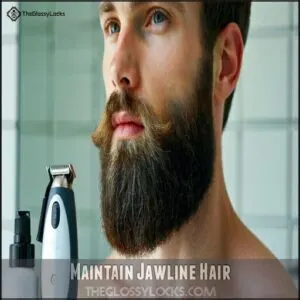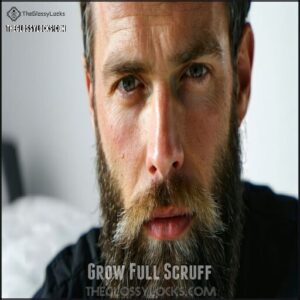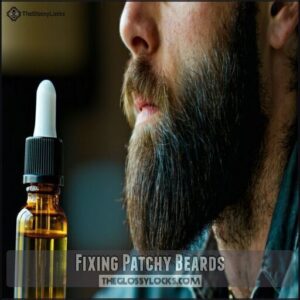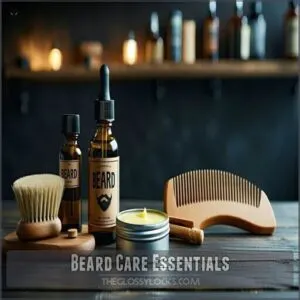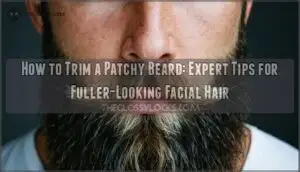This site is supported by our readers. We may earn a commission, at no cost to you, if you purchase through links.

Start by keeping it trimmed and neat—clean edges can make even sparse areas look intentional. Try styles like the Van Dyke or a short scruff to highlight your strengths while camouflaging thin spots.
A beard brush and balm can add volume and shape, while a touch of dye can create the illusion of fullness. Patience is key—let it grow for a few months before deciding on a final style.
And remember, confidence is your best accessory. Want more tricks to rock your patchy beard? Stick around for pro tips!
Table Of Contents
- Key Takeaways
- Styling Patchy Beards
- Causes of Patchy Beards
- Fixing Patchy Beards
- Beard Care Essentials
- Choosing a Beard Style
- Managing Patchy Beard Growth
- Frequently Asked Questions (FAQs)
- What causes a patchy beard?
- Should I let my beard grow if it’s patchy?
- Do beard patches fill-in?
- Are patchy beards attractive?
- What is the best thing to do with patchy beard?
- What is the 3 month beard rule?
- What is the 4 week beard rule?
- Will a patchy beard ever fill in?
- How to style a beard for formal events?
- Can patchy beards suit different face shapes?
- Conclusion
Key Takeaways
- Trim strategically to blend patches, define edges, and create a polished look that works with your natural growth.
- Use beard oil or balm to soften hair, add volume, and shape your beard while camouflaging thin spots.
- Let your beard grow for at least a month to assess patterns before deciding on a style like a Van Dyke or scruff.
- Brush daily to train growth direction and maintain a neat, intentional appearance.
Styling Patchy Beards
Styling a patchy beard isn’t about hiding flaws—it’s about working with what you’ve got.
Embrace your patchy beard—it’s not about perfection, but turning unique growth into your signature style.
With the right trims and smart shaping, you can turn uneven growth into a unique, polished look.
Artfully Clip Patches
Think of your beard as a bonsai tree—artful clipping can turn patchy areas into a masterpiece.
Use beard trimming techniques to create patch symmetry, blending sparse spots into intentional gaps.
Focus on beard shaping for patchiness by defining edges and balancing growth.
This artistic grooming approach transforms a patchy beard into a stylish, well-thought-out look.
Maintain Jawline Hair
To enhance patchy beards, focus on jawline definition for a sharp, structured scruff. Keep the neckline clean and trim neatly for a polished look.
Channel the Beckham style by maintaining jawline hair while trimming other areas. Trimming slowly can prevent irritation.
- Use a beard trimmer for precision.
- Shape the chin strap to complement facial features.
- Brush daily for even growth.
- Apply beard oil for smoothness.
Highlight Cheekbones
To enhance cheekbone definition, focus on scruff placement by growing subtle stubble in the cheek hollows while trimming around the mouth.
This trimming technique emphasizes hollow areas, creating a sculpted look. For inspiration, Beckham’s scruff highlights cheekbones beautifully, proving patchy beard solutions can be stylish.
These beard camouflage methods work wonders for achieving sharp, defined cheekbones in patchy beard styles. Many seek products for a defined beard style.
Transition to Van Dyke
The Van Dyke beard is a lifesaver for patchy beard solutions.
Focus on chin emphasis, mustache shaping, and the iconic soul patch to create Depp’s influence.
This style adds flair while masking uneven growth, and styling variations let you tweak the look—trim neatly or go bold.
It’s one of the best beard styles for patchy beards, blending sophistication with practicality.
Grow Full Scruff
If the Van Dyke feels too polished, go for full scruff. Embrace patchy beards by growing structured length variations for a laid-back appearance.
Take Keanu inspiration—longer jawline and neck hair with shorter stubble elsewhere.
Scruff maintenance is key: trim uneven growth, use beard filling techniques, and apply oil for softness. This style balances patchy coverage while staying effortlessly cool.
Causes of Patchy Beards
Patchy beards can happen for a variety of reasons, from genetics to lifestyle choices. Understanding what’s causing yours is the first step to managing it effectively.
Genetic Factors
Patchy beards often stem from beard genetics. Inherited genes play a huge role in beard density and coverage.
DHT sensitivity and follicle receptors determine how well your facial hair grows. For example, Asian beards tend to be sparser due to less sensitive receptors.
Your genetic predisposition shapes your beard growth, but embracing what you’ve got can still create a stylish look.
Hormonal Imbalance
Genetics set the stage, but beard hormones play a starring role in patchy beards.
Testosterone levels and DHT production fuel growth, yet unresponsive androgen receptors can block progress.
Stress spikes cortisol, stalling beard density.
Hormonal therapy might help if levels are low, but it’s not a magic fix. Many men also consider testosterone level support for this issue.
Balanced hormones, not just testosterone, are key to achieving consistent beard coverage.
Medical Conditions
Medical conditions like Alopecia Barbae, autoimmune conditions, or hormonal imbalances can cause beard bald spots.
Alopecia targets hair follicles, while unresponsive androgen receptors hinder growth despite normal hormone levels.
Minoxidil use can promote patchy beard recovery, but supplements may help too.
If symptoms persist, consult a dermatologist or endocrinologist for personalized advice. Treating underlying issues guarantees healthier beard growth.
Lifestyle Factors
If your beard’s patchiness feels like a cruel joke, lifestyle changes can help.
Try these:
- Stress Reduction: Lower cortisol for better beard growth.
- Sleep Quality: Boost testosterone overnight.
- Diet Choices: Include zinc-rich foods like oysters for thicker hair.
- Exercise Benefits: Weightlifting stimulates beard-growing hormones.
Hydration impacts hair health too, so drink up and groom confidently!
Fixing Patchy Beards
Fixing a patchy beard takes patience and the right approach.
From letting it grow to trying proven treatments like minoxidil or peppermint oil, you’ve got options to fill in those gaps and boost your beard game.
Letting It Grow
Embracing the initial awkwardness of patchy beard growth is key to discovering its true potential.
Letting it grow for a month helps you assess direction and identify areas of fuller coverage. Resist the urge to trim too soon—growth potential often surprises you.
Many find success with specialized beard products.
This patience reveals natural patterns and also opens up more beard styles for sparse beard areas, leading to a better understanding of your growth potential.
Dietary Changes
While growing out your patchy beard, don’t underestimate the power of a healthy diet.
What you eat can fuel hair growth and improve thickness.
Try these:
- Beard Vitamins: Include B, C, and D-rich foods like spinach and oranges.
- DHT Boosters: Snack on sorghum and broccoli.
- Healthy Fats: Avocados and olive oil work wonders.
- Protein Sources: Eggs and almonds strengthen hair follicles.
Using Minoxidil
If diet tweaks didn’t boost your beard growth, Minoxidil might help fill those stubborn bald spots.
Apply 5% foam daily to patchy areas, but watch for side effects like dryness or shedding.
Results vary, so patience is key—some see thicker coverage in months.
If Minoxidil isn’t your thing, beard fillers or darker dye can camouflage patchiness effectively.
Microneedling
Tired of waiting for results with Minoxidil? Microneedling might speed things up.
Using a Derma Roller with 0.5mm needles can stimulate beard growth by boosting blood flow and activating follicles.
Follow these beard growth tips:
- Roll twice weekly for best results.
- Use proper needle depth impact for patchy areas.
- Sanitize tools thoroughly.
- Apply growth serums post-treatment.
- Replace dull rollers monthly.
By following these steps and using Derma Roller, you can potentially enhance your beard growth experience.
Peppermint Oil Treatment
Peppermint oil is a game-changer for patchy beards. Its 3% dilution percentage boosts scalp stimulation and growth factors.
Massage it into your beard using proper application methods for best results. Always dilute with quality carrier oil to avoid irritation.
Studies in mice have shown increased follicle counts with peppermint oil application. This beard oil for growth nourishes follicles, making it a top beard growth tip to stimulate beard growth naturally.
| Benefit | Details | Why It Matters |
|---|---|---|
| Scalp Stimulation | Increases blood flow to follicles | Promotes healthier beard growth |
| Growth Factors | Boosts IGF-1 levels | Encourages thicker hair strands |
| Dilution Percentage | Use 3% peppermint oil with carrier oils | Prevents skin irritation |
| Application Methods | Massage into skin and beard | Ensures even distribution |
| Oil Quality | Choose pure, high-grade peppermint oil | Maximizes effectiveness and safety |
Beard Care Essentials
Taking care of your beard is the secret to making patchy areas less noticeable. With the right tools and techniques, you can keep it looking sharp, healthy, and intentional.
Trimming Techniques
Mastering beard trimming for a patchy beard starts with thoughtful shaping.
Use these tips:
- Stick to guard lengths that balance patchy areas.
- Define the neckline for a polished look.
- Blend sideburns into your beard for smooth shifts.
- Shape borders sharply to highlight structure.
- Embrace patch incorporation—work with gaps for unique beard styles.
Precision creates confidence!
Beard Oil and Balm
A quality beard oil hydrates skin and softens hair, while beard balm for thickness tames unruly patches.
Look for natural oil ingredients like argan or jojoba.
Application techniques matter—rub a few drops of oil or balm between your palms, then massage evenly.
Scent profiles vary, so pick one you’ll enjoy, and comparing products guarantees the best fit for patchy beard styles.
Brushing and Shaping
Start brushing daily to train your beard’s growth direction and improve patch coverage. Use a boar bristle brush for even distribution of natural oils and better shape definition.
Follow these steps:
- Brush downward for a neat look.
- Focus on patchy areas to blend them.
- Shape your beard to match your preferred beard style.
Consistency guarantees effective beard grooming, which is crucial for a well-maintained beard, and it is key to achieving the desired beard style.
Maintaining Clean Lines
Clean lines are the secret weapon for patchy beard grooming.
Focus on neckline definition—trim just above your Adam’s apple for a sharp edge.
Cheek line shaping keeps things tidy while enhancing structure.
Lip line precision and nose line detailing prevent a scruffy look.
For jawline refinement, follow natural contours.
Regular beard trimming guarantees polished beard styles that highlight your best features.
Choosing a Beard Style
Picking the right beard style can make patchy areas less noticeable and boost your confidence.
Focus on styles that work with your natural growth instead of trying to force a full beard.
Considering Patchy Areas
When dealing with beard patches, focus on the growth rate and hair direction.
Choose a beard shape that blends sparse areas naturally. Tapered styles work wonders for patch camouflage, creating a balanced look.
Highlight stronger growth zones while keeping patchy spots trimmed shorter. A well-thought-out beard style for a sparse beard can turn beard bald spots into a stylish statement.
Some men find success by addressing hormonal imbalance issues, which can be a key factor in achieving a fuller, more even beard, and thus improving overall beard style and hair direction.
Finding Inspiration
Looking for beard inspiration? Celebrities and history offer plenty of ideas.
From Keanu Reeves’ rugged patchy beard to Johnny Depp’s minimalist Van Dyke, there’s a style for everyone.
Check social media for trending beard style guides or explore historical icons like Abraham Lincoln.
Remember, your personal style matters—adapt these looks to suit your unique patchy beard and personality.
Textured Short Hair
Textured short hair is a great beard style for a sparse beard.
Use cutting techniques to blend patches into a neat look. Styling products like balm add definition while keeping it tidy.
Match your beard to your face shape and hairstyle trends for balance. A consistent maintenance routine guarantees a sharp, polished appearance.
| Tip | Details |
|---|---|
| Blend Patches | Trim uneven areas for smooth texture. |
| Use Balm | Adds shine and controls strays. |
| Match Face Shape | Align beard with facial structure. |
| Follow Trends | Stay updated with current styles. |
| Maintain Regularly | Trim weekly for consistency. |
Minimalist Patchy Beard
A minimalist patchy beard embraces subtle patch coverage by working with what you’ve got.
Focus on intentional patch placement—let sparse areas add character while trimming evenly for low-maintenance styling.
This beard style for a sparse beard highlights natural patch integration, creating a rugged yet polished look.
Follow this minimalist beard guide to transform a thin beard into a confident, effortless style.
Managing Patchy Beard Growth
Managing patchy beard growth takes patience and a few smart strategies.
By letting your facial hair grow, trimming creatively, and maintaining it regularly, you can turn uneven growth into a stylish, confident look, which requires patience.
Growing Facial Hair
Patience is key when growing facial hair, especially with a patchy beard.
The initial awkwardness can be frustrating, but letting it grow helps reveal your beard’s full potential.
Sparse area trimming and proper neck hair management keep things tidy.
Focus on beard growth tips like using beard growth products and maintaining a healthy routine to maximize growth rate factors naturally.
Resisting Trimming
Resisting the urge to trim during awkward stages is key for fuller coverage and evaluating potential.
Patchy beards need growth patience to fill uneven spots. Lifestyle changes can also support beard development.
Follow these beard growth tips:
- Let hair grow for at least 4 weeks.
- Avoid shaping too early.
- Embrace the scruffy look temporarily.
- Use beard oil to soften patches.
- Brush daily for even growth.
Creative Trimming
Creative trimming transforms a patchy beard into a stylish statement. Use tapered styles and length variation to blend sparse areas seamlessly.
Incorporate patches into the design by emphasizing angles and defining borders around your cheekbones and jawline.
Beard shaping isn’t about hiding flaws—it’s about making them work for you. A well-trimmed, intentional look can redefine your beard style for sparse beard growth, creating a unique and personalized appearance that makes the most of your features, ultimately leading to a more intentional look.
Regular Maintenance
After creative trimming, stick to a solid beard care routine.
Daily brushing keeps patches in check, while oil application and balm benefits strengthen hair and soften scruff.
Trim the neckline regularly for clean borders that scream polished, not patchy.
These beard maintenance tips aren’t just grooming—they’re styling essentials.
A patchy beard thrives with consistent care and smart beard grooming guide practices!
Promoting Hair Growth
Boost beard growth by focusing on key habits.
Eat nutrient-rich foods or take beard growth supplements packed with zinc and omega-3s. Regular exercise benefits circulation, stimulating follicles.
Improve sleep quality to enhance testosterone levels. Reduce stress—high cortisol stunts growth.
Try natural remedies like peppermint oil or beard derma rolling. Beard growth products and vitamins enhance density, promoting fuller coverage.
Frequently Asked Questions (FAQs)
What causes a patchy beard?
A patchy beard happens due to genetics, uneven hormone levels, or insensitive androgen receptors.
Factors like stress, poor nutrition, or medical conditions like alopecia can also play a role.
Sometimes, it just needs time to fill in.
Should I let my beard grow if it’s patchy?
Think of your patchy beard as a work-in-progress painting—it needs time to reveal its potential.
Let it grow for at least a month to assess patterns, then trim strategically to highlight strengths and minimize gaps.
Do beard patches fill-in?
Sometimes beard patches fill in as you age or with proper care, like improving your diet or using growth products.
However, genetics play a big role, so embracing your natural growth might be the best move.
Are patchy beards attractive?
A patchy beard is like a rugged landscape—its imperfections can highlight character.
Confidence and intentional styling make patchy beards attractive, showing individuality and effort.
It’s about owning your look, not chasing perfection.
What is the best thing to do with patchy beard?
Let it grow for a month to assess patterns, then trim smartly to blend patches.
Use beard oil for health and fullness, and embrace styles like scruff or a Van Dyke to highlight strengths.
What is the 3 month beard rule?
You might worry about patchiness, but the 3-month beard rule says to grow it out without trimming for three months.
This helps identify natural growth patterns, fuller areas, and how best to style it.
What is the 4 week beard rule?
The 4-week beard rule suggests letting your beard grow untouched for a month.
This helps you assess natural growth patterns, identify patchy areas, and plan a style that works with your unique facial hair.
Will a patchy beard ever fill in?
A patchy beard can fill in over time, but it depends on genetics, age, and care.
Focus on proper grooming, a healthy diet, and patience.
Sometimes, embracing the patchy look becomes your unique style!
How to style a beard for formal events?
Did you know 67% of men feel more confident with a well-groomed beard?
For formal events, keep it neat: trim evenly, sharpen borders, condition for shine, and pair with a custom suit—it’ll elevate your look and make you feel confident.
Can patchy beards suit different face shapes?
Tailor your patchy beard to your face shape—oval faces suit balanced styles, square faces pop with defined jawlines, and round faces benefit from angled trims.
Embrace the patches; they add character and uniqueness!
Conclusion
Think of your patchy beard as a canvas—it’s all about shaping and enhancing what’s there.
With the right beard styling tips for patchy beards, you can turn sparse growth into a bold statement.
Experiment with styles like the Van Dyke or short scruff, and don’t skip on tools like beard balm or a brush.
Growth takes time, so be patient and consistent, and most importantly, wear your beard with confidence—it’s your signature look, patchy or not.
- https://in.braun.com/en-in/male-grooming/the-world-of-styling-and-trimming/how-to-fix-a-patchy-beard
- https://warpaintformen.com/blogs/news/the-ultimate-patchy-beard-style-guide-for-men-2022?srsltid=AfmBOooZ_fzc2vaqAfjzqc9tByif09eU9oatYb5CbzZjq9vjirj8SsO8
- https://www.beardbrand.com/blogs/urbanbeardsman/patchy-beard?srsltid=AfmBOorksx18HmOIIFhLdUT7K3a11dsayzyrhbuz6rf7EMbn89DITfKh
- https://www.gq.com/story/how-to-fix-your-patchy-beard
- https://www.quora.com/How-can-I-grow-a-full-beard-if-I-have-a-patchy-one


